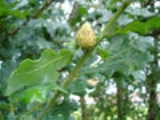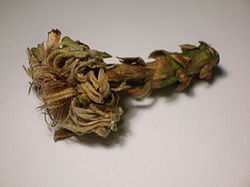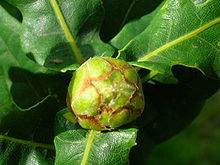
Oak artichoke gall
Encyclopedia
Oak artichoke galls, oak hop galls, larch-cone galls or hop strobile
develop as a chemically induced distortion of leaf axillary or terminal buds on Pedunculate Oak
(Quercus robur) or Sessile Oak
(Quercus petraea) trees, caused by the parthenogenetic
gall wasp
Andricus fecundator, which lays single eggs within leaf buds using their ovipositor
. The larva lives inside a smaller hard casing inside the artichoke and this is released in autumn. The asexual wasp emerges in spring and lays her eggs in the oak catkins. These develop into small oval galls which produce the sexual generation of wasps. A yew artichoke gall caused by the fly Taxomyia taxi also exists, but is unrelated to the oak-borne species. Previous names or synonyms for the species A. fecundator are A. fecundatrix, A. pilosus, A. foecundatrix, A. gemmarum, A. gemmae, A. gemmaequercus, A. gemmaecinaraeformis and A. quercusgemmae.
The hairy catkin galls are oval, pointed, unilocular and unilarval structures, 0.3 cm long, changing colour from pale green to brown. The hairs are whitish in appearance. The wasps of the sexual generation are sometimes known by the synonym Andricus fecundator forma pilosus (DvL 1982).
The gall wasp which emerges from the gall chamber in Spring will always be an asexual female. But she will proceed to lay eggs on oak catkins, with a preference for Q. robur over Q. petraea, which develop into 'hairy catkin galls'. The Oak artichoke gall is more common on bush or scrub than tree oaks.
Once the oak artichoke gall has fallen to the ground the imago may leave the gall in the following spring or may delay the emergence for 2–3 years. Galls may persist and exhibit opened scales curving outwards.
insects therefore create their own micro-habitats by forming usually highly distinctive plant structures called gall
s, made of plant tissue but controlled by the insect. Galls act as both the habitat, and food sources for the maker of the gall. The artichoke gall is formed entirely from the bud
, composed of nutritious starch and other tissues. Some galls act as "physiologic sinks", concentrating resources in the gall from the surrounding plant parts. Galls may also provide the insect with physical protection from predators.
 Mature galls are sometimes broken open by vertebrate predators to recover the larva or pupa.
Mature galls are sometimes broken open by vertebrate predators to recover the larva or pupa.
A number of insect inquiline
s live harmlessly within the oak artichoke gall and some of these, as well as Andricus itself, are parasitised by insects referred to as parasitoids. Some fungi may infect and kill the A. fecundator larvae.
Andricus curvator, the causative agent of the 'collared-bud gall' shows a marked preference for depositing its eggs on buds already colonised by A. fecundator. This may represent an early phase in the development of the inquiline mode of life.
develop as a chemically induced distortion of leaf axillary or terminal buds on Pedunculate Oak
Pedunculate Oak
Quercus robur is commonly known as the Pedunculate Oak or English oak. It is native to most of Europe, and to Anatolia to the Caucasus, and also to parts of North Africa.-Taxonomy:Q...
(Quercus robur) or Sessile Oak
Sessile Oak
Quercus petraea , the Sessile Oak, also known as the Durmast Oak, is a species of oak native to most of Europe, and into Anatolia.-Description:...
(Quercus petraea) trees, caused by the parthenogenetic
Parthenogenesis
Parthenogenesis is a form of asexual reproduction found in females, where growth and development of embryos occur without fertilization by a male...
gall wasp
Gall wasp
Gall wasps , also called Gallflies, are a family of the order Hymenoptera and are classified with the Apocrita suborder of wasps in the superfamily Cynipoidea...
Andricus fecundator, which lays single eggs within leaf buds using their ovipositor
Ovipositor
The ovipositor is an organ used by some animals for oviposition, i.e., the laying of eggs. It consists of a maximum of three pairs of appendages formed to transmit the egg, to prepare a place for it, and to place it properly...
. The larva lives inside a smaller hard casing inside the artichoke and this is released in autumn. The asexual wasp emerges in spring and lays her eggs in the oak catkins. These develop into small oval galls which produce the sexual generation of wasps. A yew artichoke gall caused by the fly Taxomyia taxi also exists, but is unrelated to the oak-borne species. Previous names or synonyms for the species A. fecundator are A. fecundatrix, A. pilosus, A. foecundatrix, A. gemmarum, A. gemmae, A. gemmaequercus, A. gemmaecinaraeformis and A. quercusgemmae.
Galls
Young galls exhibit a tuft of long hairs protruding from the centre of the 'artichoke', the remainder being overlapping scales. The hairs are attached to the more solid gall which is released and drops to the ground from August onwards. After August the 'gall' is still visible, but it is really just the distorted leaf bud after the gall has fallen. A well grown specimen can be 2.0 cm long, dark green or russet, generally developing in June and reaching its full size before autumn.The hairy catkin galls are oval, pointed, unilocular and unilarval structures, 0.3 cm long, changing colour from pale green to brown. The hairs are whitish in appearance. The wasps of the sexual generation are sometimes known by the synonym Andricus fecundator forma pilosus (DvL 1982).
The gall wasp which emerges from the gall chamber in Spring will always be an asexual female. But she will proceed to lay eggs on oak catkins, with a preference for Q. robur over Q. petraea, which develop into 'hairy catkin galls'. The Oak artichoke gall is more common on bush or scrub than tree oaks.
 |
 |
.jpg) |
Life cycle
The wasps emerging from the oak artichoke galls will be female; and these females will go on to lay a solitary egg in the male flowers of the oaks, which will cause the formation of the 'hairy catkin galls.' The flies that arise form these galls are of both sexes and the cycle then starts again after they have mated and eggs are laid in the oak buds.Once the oak artichoke gall has fallen to the ground the imago may leave the gall in the following spring or may delay the emergence for 2–3 years. Galls may persist and exhibit opened scales curving outwards.
Gall-forming insects
Some herbivorousHerbivore
Herbivores are organisms that are anatomically and physiologically adapted to eat plant-based foods. Herbivory is a form of consumption in which an organism principally eats autotrophs such as plants, algae and photosynthesizing bacteria. More generally, organisms that feed on autotrophs in...
insects therefore create their own micro-habitats by forming usually highly distinctive plant structures called gall
Gall
Galls or cecidia are outgrowths on the surface of lifeforms caused by invasion by other lifeforms, such as parasites or bacterial infection. Plant galls are abnormal outgrowths of plant tissues and can be caused by various parasites, from fungi and bacteria, to insects and mites...
s, made of plant tissue but controlled by the insect. Galls act as both the habitat, and food sources for the maker of the gall. The artichoke gall is formed entirely from the bud
Bud
In botany, a bud is an undeveloped or embryonic shoot and normally occurs in the axil of a leaf or at the tip of the stem. Once formed, a bud may remain for some time in a dormant condition, or it may form a shoot immediately. Buds may be specialized to develop flowers or short shoots, or may have...
, composed of nutritious starch and other tissues. Some galls act as "physiologic sinks", concentrating resources in the gall from the surrounding plant parts. Galls may also provide the insect with physical protection from predators.
Predators, inquilines and parasitoids

A number of insect inquiline
Inquiline
In zoology, an inquiline is an animal that lives commensally in the nest, burrow, or dwelling place of an animal of another species. For example, some organisms such as insects may live in the homes of gophers and feed on debris, fungi, roots, etc...
s live harmlessly within the oak artichoke gall and some of these, as well as Andricus itself, are parasitised by insects referred to as parasitoids. Some fungi may infect and kill the A. fecundator larvae.
Andricus curvator, the causative agent of the 'collared-bud gall' shows a marked preference for depositing its eggs on buds already colonised by A. fecundator. This may represent an early phase in the development of the inquiline mode of life.
Infestations
Removing and destroying oak artichoke galls before they dry and the wasps emerge may help to reduce the infestation. While fairly large, and sometimes present in quite large numbers on scrub specimens, they cause no measurable harm.See also
- GallGallGalls or cecidia are outgrowths on the surface of lifeforms caused by invasion by other lifeforms, such as parasites or bacterial infection. Plant galls are abnormal outgrowths of plant tissues and can be caused by various parasites, from fungi and bacteria, to insects and mites...
- Gall waspGall waspGall wasps , also called Gallflies, are a family of the order Hymenoptera and are classified with the Apocrita suborder of wasps in the superfamily Cynipoidea...
- Oak appleOak appleOak apple is the common name for a large, round, vaguely apple-like gall commonly found on many species of oak. Oak apples range in size from 2-5cm. Oak apples are caused by chemicals injected by the larva of certain kinds of gall wasp in the family Cynipidae. The adult female wasp lays single...
- Oak marble gallOak marble gallOak marble galls develop as a chemically induced distortion of leaf buds on pedunculate oak , or sessile oak trees, caused by the parthenogenetic gall wasp which lays eggs within leaf buds using their ovipositor...
- Alder tongue gallAlder tongue gallTaphrina alni is a fungal plant pathogen that causes Alder tongue gall, a chemically induced distortion of female alder catkins ....
- Knopper gallKnopper gallAndricus quercuscalicis is a gall wasp species inducing Knopper galls.Knopper galls develop as a chemically induced distortion of growing acorns on Pedunculate Oak trees, caused by gall wasps, which lay eggs in buds with their ovipositor...
- Rose bedeguar gallRose bedeguar gallThe Rose bedeguar gall, Robin's pincushion gall, or Moss galldevelops as a chemically induced distortion of an unopened leaf axillary or terminal buds mostly on Field Rose or Dog rose shrubs, caused by the parthenogenetic hymenopteran gall wasp , previous synonyms are D...
- Pineapple gall
- Rhabdophaga rosariaRhabdophaga rosariaRhabdophaga rosaria is a gall midge which forms Camellia galls or terminal rosette gall on willow species.-Description:Willows are extremely susceptible to gall induction and growth manipulation and Salix is one of the plant genera with the highest known numbers of associated galler species.The...
- Eriophyes tiliae

